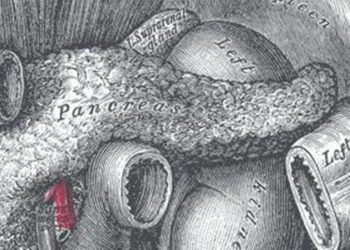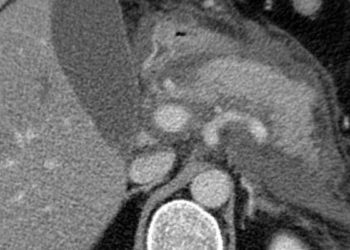CT evaluation in pancreatitis strongly correlates with patient outcomes [Classics Series]
This study summary is an excerpt from the book 2 Minute Medicine’s The Classics in Medicine: Summaries of the Landmark Trials
1. Among patients with acute pancreatitis, the presence and degree of pancreatic necrosis correlated with average hospital length of stay, complications, and mortality.
2. By combining existing an existing acute pancreatitis grading system with computed tomography (CT) evaluation of pancreatic necrosis, the authors generated a CT Severity Index that strongly correlated with patient outcomes.
Original Date of Publication: February 1990
Study Rundown: Acute pancreatitis is a common condition involving inflammation of the pancreas. Though most patients have a benign course without associated complications, some develop severe disease associated with high rates of morbidity and mortality. Numerous attempts have been made to estimate patient prognosis in acute pancreatitis, including attempts to correlate imaging findings with patient outcomes using CT. Due to limitations in early CT technology, however, pancreatitis grading scales suffered from poor sensitivity and specificity and were not widely used. In this trial, the study authors attempted to build on these prior works by using contrast-enhanced CT to evaluate the presence and degree of pancreatic necrosis as a prognostic indicator in acute pancreatitis. Using a prospective patient cohort at a single institution, the study authors demonstrated a strong, positive relationship between pancreatic necrosis and patient outcomes. Compared to those with a normal-appearing pancreas by CT, patients with necrosis had significantly longer hospital lengths of stay and higher rates of complications. All deaths in the study cohort were in patients with pancreatic necrosis. Combining this information with previously-described rating scales, the authors were then able to generate the CT Severity Index (CTIS), a numeric scale to predict the risk of complications and death. Applying this scale to the study cohort, morbidity and mortality strongly correlated with CTIS score. Primary limitations of this study included modest sample size and the associated low mortality rate. Subsequent work in pancreatitis imaging has expanded upon this landmark trial, the results of which remain in modern clinical practice as the modified CTIS.
Click to read the study in Radiology
In-Depth [randomized control trial]: Eighty-eight patients (mean age, 52 years) with signs and symptoms of acute pancreatitis were enrolled. All patients were initially managed with standard medical therapy, including nasogastric suction, analgesia, and intravenous fluids. Surgical intervention was pursued in patients with sepsis refractory to medical management. All patients underwent CT imaging of the abdomen with intravenous and oral contrast for evaluation of pancreatic necrosis at the time of admission, and a subset of patients received additional, subsequent CT imaging (mean number of CTs/patients, 2.9). Scans were interpreted blindly and assessed for two specific features: the patient’s five-point pancreatitis grade, based on previously published data; and the qualitative degree of decreased pancreatic parenchymal enhancement. This latter variable was taken to represent the presence of pancreatic necrosis, and was reported as one of four possible severities. Additional collected data included Ranson’s score, hospital length of stay, morbidity—defined as pancreatic abscess or pseudocyst formation—and mortality. At the end of the trial, 66 (75.0%) patients had uncomplicated courses and recovered with medical therapy alone, while 22 (25.0%) patients required surgical intervention. Five (5.7%) patients died. In total, pancreatic necrosis was detected in 18 (20.5%) patients. Average length of stay was 109 days among patients with > 50% necrosis, as compared to 25 days among those without evidence of necrosis at presentation. The average Ranson’s score (a marker of severity, maximum score 11) was 1.9 among those without necrosis and 5.5 among those with > 50% necrosis. Patients with CT evidence of necrosis had morbidity and mortality rates of 82% and 23%, respectively, as compared with respective rates of 6% and 0% among those without necrosis. The positive predictive value for abscess formation of 77% among patients with necrosis, and the negative predictive value of abscess formation among those without necrosis was 97%. By combining pancreatitis grade and CT extent of pancreatic necrosis, a CT Severity Index was created with a maximum score of 10 (highest severity). Among study patients with a CTSI 0-3, there was 3% mortality and 8% morbidity; among patients with CTSI 7-10, mortality and morbidity were 17% and 92%, respectively.
Balthazar EJ, Robinson DL, Megibow AJ, Ranson JH. Acute pancreatitis: value of CT in establishing prognosis. Radiology. 1990 Feb 1;174(2):331–6.
©2022 2 Minute Medicine, Inc. All rights reserved. No works may be reproduced without expressed written consent from 2 Minute Medicine, Inc. Inquire about licensing here. No article should be construed as medical advice and is not intended as such by the authors or by 2 Minute Medicine, Inc.






![RSV positivity associated with reduced serious bacterial infection risk [Classics Series]](https://www.2minutemedicine.com/wp-content/uploads/2013/09/800px-Respiratory_syncytial_virus_01-75x75.jpg)
